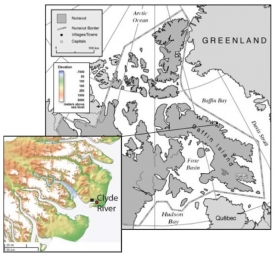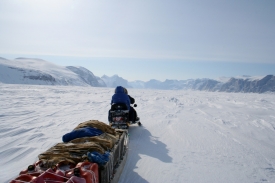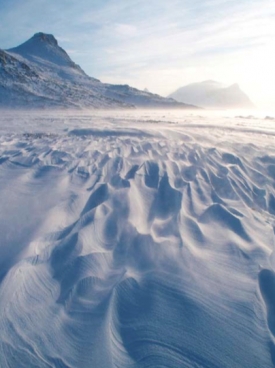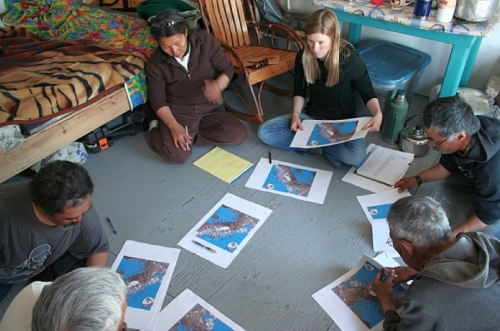Introduction

Climate scientists and others investigating changes in the Arctic have increasingly incorporated indigenous knowledge and observations in their research. Valuable insights are gained by linking indigenous knowledge with scientific research; however, finding formal methods to connect culturally divergent observations can be a complicated task.
Dr. Shari Gearheard is a research scientist with the University of Colorado's National Snow and Ice Data Center. Unlike most of her scientific colleagues, she lives year-round in the small arctic town of Clyde River, an Inuit community of approximately 850 people located on the northeastern shore of Baffin Island in the Canadian territory of Nunavut. Gearheard has worked for over 15 years with Inuit hunters and Elders documenting their knowledge and observations of local changes in the climate and environment.
Case Study Introduction
During her studies, Gearheard has built connections with local people interested in working with scientists studying climate and environmental change in the Arctic. One product of these connections is a case study that analyzes the level of agreement between local weather station data and the observations of wind pattern changes made by local experts at Clyde River. The study revealed inconsistency between the two sets of observations. Clyde River Inuit report an increase of variability in wind speed and direction since the 1980s, but data from the local weather station did not consistently indicate the same changes in wind patterns over those years. For Gearheard, the differences in observations offer interesting lessons to be learned.
Inuit Observations of Wind Patterns

For many Inuit hunters in the Arctic, weather is the determining factor for daily activity. Of all weather variables, wind is the element that most concerns hunters. Travel and hunting activities are constrained by strong winds that reduce visibility with blowing snow and create hazardous conditions including whiteouts, large waves, and moving ice. Shifting wind directions can bring additional hazards such as fog, open water leads in the sea ice, and altered orientation of snow features. Gearheard has recorded over one hundred interviews with experienced, active hunters and Elders who have extensive knowledge of wind and weather processes.

For Clyde River Elders, the most noticeable changes related to wind were a shift in the prevailing wind direction from northwest toward north, and an increase in variability of wind speeds and directions. Experienced hunters are able to keep track of wind direction and strength while traveling by observing surface snow forms, blowing snow, and clouds. The shift in prevailing seasonal wind direction affects snowdrifts that run parallel to prevailing wind and create directional navigation aids known as uqulurait. This can present dangerous circumstances for inexperienced travelers. Without expert skills in keeping track of the changes of shifting winds, they may follow the snowdrifts in the wrong direction and become lost. Observers also note that during the past 30 years winds may shift direction several times over the course of one to two days and pick up or die down suddenly, especially in the spring. This makes it difficult to predict conditions or know if it is safe to go out on the water or sea ice. Additionally, winter winds are now both stronger and longer lasting than in the past. These winds pack the snow so hard that it is difficult to build igloos for shelter in bad weather.
Clyde River observers make the point that although recent conditions have been mentioned in the past and weather has always been unpredictable, what is unprecedented is how quickly conditions are now changing and the persistence of this unpredictability over time.
Weather Station Records of Wind Patterns
Scientific observations of wind are made quite differently. Stationary instruments gather data individually and separately. In this study, statistical methods were used to interpret surface measurements made at the only available meteorological station for the area, maintained by Environment Canada at the Clyde River airport. Since 1977 this station has recorded hourly wind speed as a 2-minute average taken at the beginning of the hour. Time series data from 1980–2005 was analyzed on a monthly basis to allow comparison to the seasonal conditions reported by Clyde River Inuit. Both linear regression and a loess curve analyses were performed to identify overall trends in mean monthly wind speeds, wind direction, and wind variance.
Results indicated that on an annual basis, the proportion of winds exceeding 30 km/hr had not significantly changed, however, the proportion of wind less than 20km/hr had significantly decreased. The lower proportion of calm winds aligned with Inuit observations of generally windier conditions. In contrast, no consistent changes in the variability of wind speed and wind duration were apparent from statistical analyses of the data. Similar methods were used to examine the trends in mean wind direction and wind direction variance. No significant changes in wind direction were found, some increase in the mean range of wind directions was revealed, and there was no notable change in the prevalence of northwest winds according to station records.
Discussion of Divergent Observations
Overall there is limited agreement between Inuit observations and weather station data analyses of wind change at Clyde River. Gearheard and colleagues were particularly interested in what could be learned from the lack of agreement and suggest three possible explanations.
First, the weather station records are not representative of the areas where local hunters travel. The weather station is located near the sea in relatively flat terrain. Hunters often travel long distance in fjords that are bordered by high cliffs and mountains. Given the complex and varied topography of the area, a range of wind conditions is expected and the station may not be recording events that are of interest to local hunters. However, some correlation of general wind patterns could still be expected. Gearheard and colleagues suggest that future studies of wind variability should include data from additional weather stations (a new project by Gearheard and colleagues has since installed three new weather stations in the region). Gearheard's group also recommends that scientists collaborate more with local hunters to better understand the degree to which Inuit rely on information from the weather station, and learn more about their weather observing and forecasting techniques.
The second explanation considered is that because Inuit observations rely on personal recollections of events many years ago and on oral history records from older generations, they may be elastic. The importance of wind patterns may have changed over time. New technology and activity such as replacing dog teams with snowmobiles for hunting could have changed how weather was observed. Gearheard's research suggests that studies on long-term changes in hunter-wind interactions could clarify this possibility.
Thirdly, the study suggests that since Inuit and meteorological records do not observe the same phenomena, a comparison may be invalid. Inuit are more concerned with the sudden and unpredictable changes in wind patterns that affect safety in travel and hunting. Weather stations record events over different time scales, at a fixed location, and with no sensitivity to other environmental factors (such as blowing snow) that may increase perceived severity of wind at a given speed. Further study could account more precisely for the concerns and knowledge of Inuit in terms of various wind events and how those events might, or might not, be captured in weather station records.
Lessons for Designing Research Teams
Gearheard and colleagues suggest that future studies comparing observations and records of the same event might help understand the differences in perspective. For example, a sudden change in wind patterns reported by Inuit observers could be compared to records captured at the weather station for the same time. Comparison of complementary observations could reveal useful information about general wind patterns, frequency of events, and the difference between statistically and personally significant environmental changes.

Gearheard's continued work focuses on gathering additional data and coordinating projects that bring Inuit and scientists together to design and implement research. In a recent study of changes in weather persistence at Baker Lake, Nunavut, Canada, Inuit observations and understanding of weather variability was linked with results from prior meteorological studies to develop the research questions for the study. A current project entitled Siku-Inuit-Hila (Sea Ice-People-Weather) is a multidisciplinary and multicultural study of sea ice and sea use. In this innovative research model, project teams of indigenous experts from the communities of Barrow, Alaska; Clyde River, Nunavut, Canada; and Qaanaaq, Greenland work directly with sea ice scientists in all aspects of the study, including conceptualization, project design, field work, analysis, and reporting of results. Local community members monitor sea ice stations throughout the entire year, collecting sea ice thickness and temperature data and combining that information with their own qualitative observations. By bringing together Inuit knowledge, social science methods, and physical science, the team is able to examine the variability of sea ice characteristics on multiple scales through all seasons at three separate locations across the Arctic.
Gearheard notes that linking indigenous knowledge with climate change science requires recognition of the distinct differences between the two, and an understanding that neither is superior. Indigenous knowledge must be documented with care and in collaboration with indigenous partners to make sure that interpretation, analysis, and application of the information is correct.
For further information about Shari Gearheard's work, please see her website at the National Snow and Ice Data Center: http://nsidc.org/research/bios/gearheard.html or contact Dr. Gearheard at shari.gearheard [at] nsidc.org.
References
S. Gearheard, M. Pocernich, R. Stewart, J. Sanguya, and H. Huntington. 2010. Linking Inuit knowledge and meteorological station observations to understand changing wind patterns at Clyde River, Nunavut. Climatic Change 100(2): 267-294, doi:10.1007/s10584-009-9587-1.
Weatherhead, E., S. Gearheard, and R. G. Barry. 2010. Changes in weather persistence: Insight from Inuit knowledge. Global Environmental Change 3: 523-528, doi:10.1016/j.gloenvcha.2010.02.002.
S. Gearheard. 2008. A Change in the Weather. Natural History February: pages 33-38.
S. Gaidos. 2010. Trusting the Public. ScienceCareers, June: from the journal Science, AAAS.
